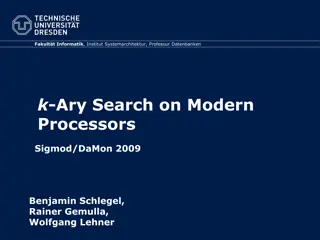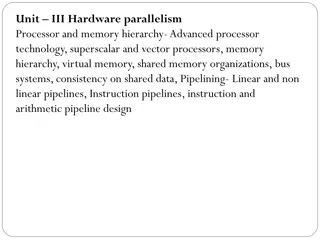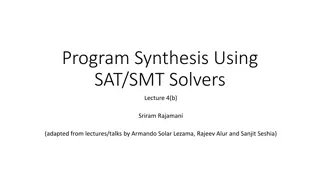Universal Two-Qubit Computational Register for Trapped Ion Quantum Processors
Universal two-qubit computational register for trapped ion quantum processors, including state preparation, gates, and benchmarking. The experimental setup and results are discussed.
0 views • 14 slides
Towards Single-Event Upset Detection in Hardware Secure RISC-V Processors
This research focuses on detecting single-event upsets (SEUs) in hardware-secure RISC-V processors in radiation environments, such as high-energy physics and space applications. Motivated by the potential data errors, unpredictable behavior, or crashes caused by SEUs, the study explores fault inject
5 views • 17 slides
Superscalar Processors in Processor Design
Explore the concept of superscalar processors in processor design, including the ability to execute instructions independently and concurrently. Learn about the difference between superscalar and superpipelined approaches, instruction-level parallelism, and the limitations and design issues involved
1 views • 55 slides
Computer Architecture: A Comprehensive Overview by Prof. Dr. Nizamettin AYDIN
Explore the realm of computer architecture through the expertise of Prof. Dr. Nizamettin AYDIN, covering topics like RISC characteristics, major advances in computers, comparison of processors, and the driving force for CISC. Delve into the evolution of processors, register optimization, and the tra
0 views • 42 slides
Introduction to Intel Assembly Language for x86 Processors
Intel Assembly Language is a low-level programming language designed for Intel 8086 processors and their successors. It features a CISC instruction set, special purpose registers, memory-register operations, and various addressing modes. The language employs mnemonics to represent instructions, with
3 views • 12 slides
Shared Memory Systems in Computer Architecture
Shared memory systems in computer architecture allow all processors to have direct access to common physical memory, enabling efficient data sharing and communication among processors. These systems consist of a global address space accessible by all processors, facilitating parallel processing but
2 views • 19 slides
Computer System Architectures
Computer systems can be categorized into single-processor and multiprocessor systems. Single-processor systems have one main CPU but may also contain special-purpose processors. Multiprocessor systems have multiple processors that share resources, offering advantages like increased throughput, econo
2 views • 25 slides
PowerPC Architecture Overview and Evolution
PowerPC is a RISC instruction set architecture developed by IBM in collaboration with Apple and Motorola in the early 1990s. It is based on IBM's POWER architecture, offering both 32-bit and 64-bit processors popular in embedded systems. The architecture emphasizes a reduced set of pipelined instruc
3 views • 13 slides
Contrasting RISC and CISC Architectures
Contrasting RISC (Reduced Instruction Set Computing) and CISC (Complex Instruction Set Computing) architectures, the images and descriptions elaborate on their advantages and disadvantages, with a focus on multiplying two numbers in memory using a CISC approach. CISC processors aim to complete tasks
1 views • 35 slides
ARM RISC Design Philosophy and Its Impact
Delve into the world of ARM processors, exploring the RISC design philosophy that underpins their efficiency and widespread application. Learn about key principles, compare RISC with CISC, and discover how ARM's simplicity, orthogonality, and efficient architecture contribute to its dominance in mob
0 views • 12 slides
Design and Implementation of Shifters in ALU for Single-Cycle Processors
The detailed discussion covers the construction of a multifunction Arithmetic Logic Unit (ALU) for computer processors, specifically focusing on the design and implementation of shifters. Shift operations such as SLL, SRL, SRA, and ROR are explained, with insights into shifting processes and data ex
1 views • 5 slides
k-Ary Search on Modern Processors
The presentation discusses the importance of searching operations in computer science, focusing on different types of searches such as point queries, nearest-neighbor key queries, and range queries. It explores search algorithms including linear search, hash-based search, tree-based search, and sort
1 views • 18 slides
Enhancing I/O Performance on SMT Processors in Cloud Environments
Improving I/O performance and efficiency on Simultaneous Multi-Threading (SMT) processors in virtualized clouds is crucial for maximizing system throughput and resource utilization. The vSMT-IO approach focuses on efficiently scheduling I/O workloads on SMT CPUs by making them "dormant" on hardware
0 views • 31 slides
Accelerating Lemma Learning Using Joins in Satisfiability Modulo Theories
Explore the use of joins in accelerating lemma learning within the context of Satisfiability Modulo Theories (SMT). The study covers various SMT applications at Microsoft and delves into the development of the Z3 solver. Key topics include theories, arithmetic operations, array theory, uninterpreted
0 views • 25 slides
Dynamic Load Balancing on Graphics Processors: A Detailed Study
In this comprehensive study by Daniel Cederman and Philippas Tsigas from Chalmers University of Technology, the focus is on dynamic load balancing on graphics processors. The research delves into the motivation, methods, experimental evaluations, and conclusions related to this critical area. It cov
0 views • 57 slides
Scaling Multi-Core Network Processors Without the Reordering Bottleneck
This study discusses the challenges in packet ordering within parallel network processors and proposes solutions to reduce reordering delay. Various approaches such as static mapping, single SN approach, and per-flow sequencing are explored to optimize processing efficiency in multi-core NP architec
0 views • 22 slides
- Exceptions in Modern High-Performance Processors
- Overview of exceptions in pipeline processors, including conditions halting normal operation, handling techniques, and example scenarios triggering exception detection during fetch and memory stages. Emphasis on maintaining exception ordering and performance analysis in out-of-order execution proc
3 views • 28 slides
Interrupt Processing Sequence in X86 Processors
X86 processors have 256 software interrupts, functioning similarly to a CALL instruction. When an INT n instruction is executed, the processor follows a sequence involving pushing the flag register, clearing flags, finding the correct ISR address, and transferring CPU control. Special interrupts lik
1 views • 10 slides
Should Ghana Provide Discounts on Cocoa Beans for Local Processors? A Case Study
Ghana's cocoa sector plays a significant role in the country's economy, yet less than 25% of cocoa beans are processed locally, limiting its market share. This case study explores the impact of local processing on Ghana's cocoa industry and discusses the dilemma of value addition. The question of wh
0 views • 14 slides
Constructive Computer Architecture: Multistage Pipelined Processors
Explore the concepts of multistage pipelined processors and modular refinement in computer architecture as discussed by Arvind and his team at the Computer Science & Artificial Intelligence Lab, Massachusetts Institute of Technology. The content delves into the design and implementation of a 3-stage
0 views • 28 slides
Data Hazards in Pipelined Processors: Understanding and Mitigation
Explore the concept of data hazards in pipelined processors, focusing on read-after-write (RAW) hazards and their impact on pipeline performance. Learn strategies to mitigate data hazards, such as using a scoreboard to track instructions and stall the Fetch stage when necessary. Discover how adjusti
0 views • 23 slides
Instruction Flow Techniques in High-IPC Processors
Explore the intricate processes involved in optimizing instruction flow within high-IPC processors, tackling challenges such as control dependences, branch speculation, and branch direction prediction. Learn about the goals, impediments, branch types, and implementations that shape the efficient exe
0 views • 80 slides
Leveraging Graphics Processors for Accelerating Sonar Imaging via Backpropagation
Utilizing graphics processors to enhance synthetic aperture sonar imaging through backpropagation is a key focus in high-performance embedded computing workshops. The backpropagation process involves transmitting sonar pulses, capturing returns, and reconstructing images based on recorded samples. T
0 views • 18 slides
Z3: An Efficient SMT Solver
Z3 is an efficient Satisfiability Modulo Theories (SMT) solver that integrates various decision procedures for program analysis, verification, and test case generation. It supports linear arithmetic, bit-vectors, uninterpreted functions, quantifiers, and offers an extensive API for different program
0 views • 16 slides
SMT-LIB: The Satisfiability Modulo Theories Library Overview
The Satisfiability Modulo Theories Library (SMT-LIB) is a comprehensive tool for formal reasoning in various supported theories such as arrays, bit vectors, and integer and real arithmetic. It provides a wide range of supported sublogics for precise specifications and verifications. Moonzoo Kim, fro
0 views • 14 slides
Performance Comparison of Optimization Solvers on Intel Xeon X5650 Processors
Experiment results comparing the performance of optimization solvers (BARON, Antigone, LindoGlobal, SCIP, Couenne) on Intel Xeon X5650 2.66Ghz processors with 48GB RAM. The study includes 369 NLPs from various libraries and an aggregate analysis of 1740 NLPs and MINLPs. Performance profiles generate
1 views • 6 slides
Flynn's Taxonomy: Classification of Computer Architectures
Michael Flynn's 1966 classification divides computer architectures into SISD, SIMD, MISD, and MIMD based on the number of instruction streams and data streams. SISD corresponds to traditional single-processor systems, SIMD involves multiple processors handling different data streams, MISD has multip
0 views • 10 slides
Introduction to DSP Processors and Applications
DSP processors play a crucial role in various applications such as communications, audio and video processing, graphics, navigation, radar, and more. These processors are designed to efficiently handle repetitive numerical calculations, maintain numeric fidelity, and provide real-time processing cap
0 views • 43 slides
Verification and Synthesis using SMT Solvers
This paper explores the use of SMT solvers for program verification and synthesis, focusing on discovering invariants with arbitrary quantification and boolean structure. It delves into proving programs correct by inferring program states and discusses tasks like sortedness and permutation. The auth
0 views • 18 slides
Scheme Monitoring Tool for Pipe Water Supply Schemes in Assam
Providing safe drinking water to rural households is a key goal of the Jal Jeevan Mission in Assam. The Scheme Monitoring Tool (SMT) simplifies the tracking and monitoring of Pipe Water Supply Schemes, ensuring effective project implementation and timely completion. Developed to streamline the daily
0 views • 9 slides
Advanced Processors
Delve into the world of DSP processors and hardware architectures for signal processing, exploring topics such as Harvard Architecture, pipelining, and specialized instructions like MAC. Discover the simplified architecture of standard microprocessors and the need for DSP architecture with elements
0 views • 59 slides
CS 295: Modern Systems Modern Processors - SIMD Extensions
This content covers topics on modern processors, including SIMD extensions, performance improvements, Flynn Taxonomy Recap, Intel SIMD extensions, registers, SSE/AVX data types, and Sandy Bridge Microarchitecture. It provides insights into transparent performance improvements, explicit performance e
0 views • 34 slides
Reviewed Updates and System Upgrades in RMS and SMT
This update covers reviewed revisions to AMWG procedures and TDSP AMS data practices matrix, system upgrades, hardware failures analyzed for root cause, planned release for SMT, Help Desk calls and tickets status, active AEPN, CNP, Oncor data agreements, and upcoming meetings via WebEx. Find out mor
0 views • 7 slides
Understanding Superscalar vs. VLIW Processors: Architecture and Differences
Explore the world of Superscalar and VLIW processors, two advanced technologies designed to enhance performance by executing multiple instructions in parallel. Delve into the architectures, differences, and operational principles of these processors to gain insights into their unique capabilities an
0 views • 22 slides
Understanding Processor Technology and Memory Hierarchy Advancements
Explore advanced processor technologies including superscalar and vector processors, memory hierarchy concepts, virtual memory implementation, shared memory organizations, bus systems, and pipeline design. Delve into the design space of processors, comparing CISC and RISC architectures, and discover
1 views • 30 slides
Advanced Program Synthesis Techniques Using SAT/SMT Solvers
Explore advanced topics in program synthesis through SAT/SMT solvers, including sketching examples, swapping techniques, and SyGus with Syntax Guided Synthesis. Understand constraint systems, computational problems, and theory fixes for function synthesis. Dive into SyGus examples for theory QF-LIA
1 views • 18 slides
Evolution of Intel x86 Processors at Carnegie Mellon
Explore the evolution of Intel x86 processors at Carnegie Mellon, from the introduction of the 8086 in 1978 to the latest Core i7 Broadwell models in 2015. Learn about the milestones, features, and advancements in machine-level programming, assembly basics, and the dominance of Intel processors in t
0 views • 44 slides
Account Management and SMT Services Overview
Explore key aspects of 3rd party registration, account management, and SMT services including data timelines, service availability, anomalies, account statistics, and ODR details. Gain insights into service performance and trends in relation to account management processes.
0 views • 5 slides
Soft Vector Processors and Streaming Pipelines in Action
Explore the implementation of soft vector processors with streaming pipelines, addressing data parallel problems on FPGAs, overlays, processors, and examples like the N-Body Problem. Dive into custom vector instructions, VectorBlox MXP, CVI complications, and heterogeneous lanes for efficient proces
0 views • 21 slides
Godson Processors: Evolution and Features
Discover the evolution of Godson processors, from the inception of BLX IC Design Corporation to the latest Godson-3B1500 model. Explore the key features, architectures, and advancements in this comprehensive overview of Godson processors.
0 views • 17 slides







































